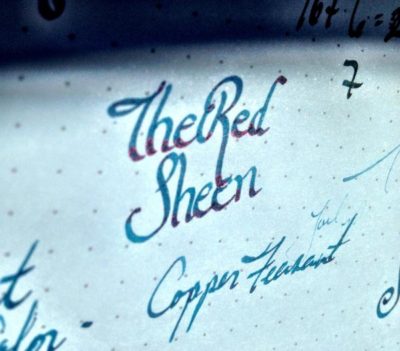When I was eleven years old I started at the local girls’ grammar school, where it was mandatory to use a fountain pen for “neat work”: homework, tests and so on. My parents bought me a Parker 45 Flighter, a pretty swanky pen for a kid, and I felt very grown up using it. That pen served me well through school and university, and for years it was the only fountain pen I owned, apart from a battered vintage Conway Stewart that I sadly lost somewhere along the way.
Then came the internet — and online stationery shops. Suddenly my eyes were opened to a whole new world of inexpensive fountain pens from around the world, and a bewildering array of inks. In the last five years, my collection has grown from a handful of pens and cartridges to a current total of 67 pens and almost a hundred bottles of ink!
I could write at exhaustive length about them all, but for the sake of everyone’s sanity I will highlight a few that bring me real joy.
Pens
One of the great things about modern fountain pens is that in addition to the ink cartridges and converters that I knew as a teenager, some manufacturers are bringing back filling systems that were previously only available in vintage pens, such as piston or vacuum mechanisms. These hold a lot more ink and usually have transparent barrels so you can see the ink inside.

One of my favourite models is the TWSBI “Vac Mini” (second from bottom), a compact vacuum-filler pen that uses a special inkwell; it’s kinda hard to explain, so you might want to check out this video (skip to 5:30 for the pen review or 11:00 for the inkwell demo, as there’s a lot of chat at the beginning):
The Vac Mini is also great for travelling, as the piston seal can be tightened to prevent leakage on planes. Not that I’ve ever had a fountain pen leak on a flight, but then I’m always careful to carry my pens upright to avoid trapping air bubbles.
Another favourite fountain pen happens to be the most expensive in my collection: a Pilot Vanishing Point (now mostly marketed as the “Capless”, but I prefer the older name). This is another brilliant piece of engineering, because it’s a retractable fountain pen. How cool is that? The reason this design is so unusual — and expensive — is that it requires a far more complex mechanism than your average clicky biro. Unlike ballpoint ink, fountain pen ink dries up quickly when exposed to air, so the business end of the Vanishing Point has a tiny hatch that closes as the nib retracts, sealing the pen against air, dust and pocket lint.

The only downside is that the clip is along the top of the grip, so it’s not ideal for long writing sessions and may be uncomfortable depending on how you hold a pen, but it’s perfect for carrying around to jot down a quick note or idea.
Ink
When I was in school, there were only a handful of fountain pen ink colours around, and if you wanted to be taken seriously your choices were black, blue, or blue-black. Boring! Nowadays there are a plethora of deep purples, teals, browns, and other attractive shades that are nonetheless subdued enough for everyday use, as well as some spectacular inks I could only have dreamed of as a teenager.
My favourite everyday inks are dark greys and grey-purples. Pilot Iroshizuku is a high-end Japanese ink that comes packaged almost like a perfume, in a silver cardboard box containing a heavy glass bottle. My current favourite colours are Fuyu Syogun (Old Man Winter), a cool blue-grey, and Kiri Same (Autumn Shower), a warm brownish grey.
At the other end of the spectrum, so to speak, are inks containing metallic particles to provide glitter effects, or special chemical formulations that give the ink a contrasting sheen. Both kinds benefit from a broad pen nib that lays down plenty of ink, so I mostly use them for headers in my journal. They’re hard to photograph, though, so here are some examples I found online:
Diamine Shimmer – new 2017 colours
I already had some of the original Shimmer colours that Diamine brought out in 2015, but I couldn’t resist adding four of these new ones to my collection — perfect for signing Christmas cards!

Swatches by Nick Stewart, https://quinkandbleach.wordpress.com/
Shading – Sailor Jentle “Yama Dori” (Copper Pheasant)
See how this deep turquoise ink shades to red where it pools at the bottom of each stroke? You need a smooth high-quality paper such as Rhodia or Tomoe River to bring out the best in these inks, but it’s worth it!

A fountain pen may be messier than a biro and occasionally unreliable, but nothing can quite compare to a well-polished nib gliding across paper, leaving a shining trail of colour in its wake. It connects me to my predecessors, scratching away with dip pens or quills by candlelight, and makes even the dullest prose look magical. And when the zombie apocalypse comes and our computers are nothing but expensive paperweights, my fountain pens will still be writing—and still bringing me joy.
Anne Lyle was born in what is popularly known as “Robin Hood Country”, and grew up fascinated by English history, folklore, and swashbuckling heroes. She is the author of the award-nominated Elizabethan fantasy novel “The Alchemist of Souls” and its two sequels, and is currently working on an as-yet-untitled alchemypunk series.
When not writing you can usually find her drawing, knitting, watching Netflix or playing Assassin’s Creed. She lives in Cambridge with her family, two neurotic cats and enough fountain pens to last several lifetimes. Online you can find her at her website or on twitter.







